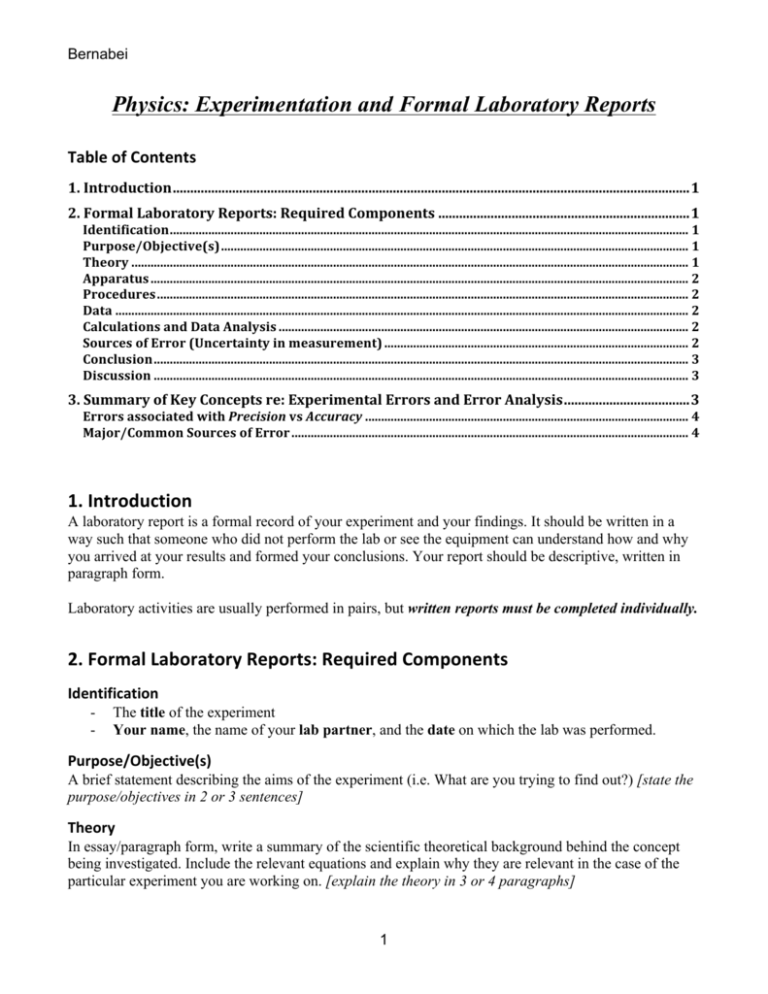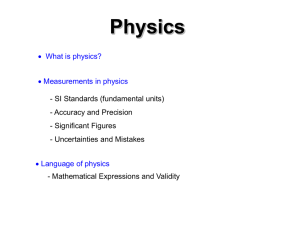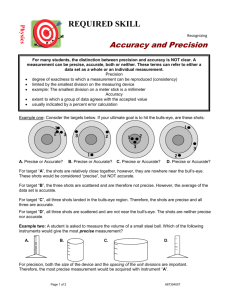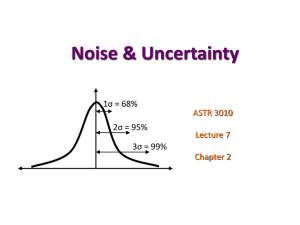Physics Lab Report Template: Guidelines & Requirements
advertisement

Bernabei Physics: Experimentation and Formal Laboratory Reports Table of Contents 1. Introduction .................................................................................................................................................... 1 2. Formal Laboratory Reports: Required Components ........................................................................ 1 Identification .................................................................................................................................................................. 1 Purpose/Objective(s) .................................................................................................................................................. 1 Theory .............................................................................................................................................................................. 1 Apparatus ........................................................................................................................................................................ 2 Procedures ...................................................................................................................................................................... 2 Data ................................................................................................................................................................................... 2 Calculations and Data Analysis ................................................................................................................................ 2 Sources of Error (Uncertainty in measurement) ............................................................................................... 2 Conclusion ....................................................................................................................................................................... 3 Discussion ....................................................................................................................................................................... 3 3. Summary of Key Concepts re: Experimental Errors and Error Analysis .................................... 3 Errors associated with Precision vs Accuracy ..................................................................................................... 4 Major/Common Sources of Error ............................................................................................................................ 4 1. Introduction A laboratory report is a formal record of your experiment and your findings. It should be written in a way such that someone who did not perform the lab or see the equipment can understand how and why you arrived at your results and formed your conclusions. Your report should be descriptive, written in paragraph form. Laboratory activities are usually performed in pairs, but written reports must be completed individually. 2. Formal Laboratory Reports: Required Components Identification - The title of the experiment Your name, the name of your lab partner, and the date on which the lab was performed. Purpose/Objective(s) A brief statement describing the aims of the experiment (i.e. What are you trying to find out?) [state the purpose/objectives in 2 or 3 sentences] Theory In essay/paragraph form, write a summary of the scientific theoretical background behind the concept being investigated. Include the relevant equations and explain why they are relevant in the case of the particular experiment you are working on. [explain the theory in 3 or 4 paragraphs] 1 Bernabei Apparatus - Include a clearly labeled diagram of the experiment set-up, hand drawn by you (do NOT copy/paste photos from the internet. You may include photos you have personally taken, but photos are not a replacement for hand-drawn diagrams – Drawing and labeling sketches of experiments is a skill that you must practice, and it is required for your lab) - Include a complete list of apparatus: o name the specific equipment you used and state the measurement limit (smallest division) e.g. “meter stick, measurement limit = 1 mm”; “triple beam balance, measurement limit = 0.1g”; “Escali Alimento 136KP digital scale, measurement limit = 1g” Procedures Summarize the steps taken in performing the experiment. Explain any deviations/changes from the original instruction. Remember that people will read your report (and you will write it) AFTER the lab was completed, so you must WRITE IN PAST TENSE!!!!! It is appropriate to write in 1st person (e.g. “I used one piece of clear tape to connect the ticker tape to the 200g mass, and then threaded the tape through the electronic timer”). Data - Quantitative Data and Observations: Present data from measurements clearly, including all units and symbols. It is often helpful to use data tables and graphs. All graphs must be in proper format for physics, as described in the “Graphing Guidelines” handout. - Qualitative Data and Observations: Descriptive observations of relevant information that cannot be easily measured (e.g. textures, colours, sounds). You may use words and diagrams to represent qualitative data/observations. Calculations and Data Analysis Show calculations and data analysis. If the same calculation is repeated several times for a series of data points only one sample calculation needs to be shown. Include the % error calculation when an “accepted value” exists (e.g. acceleration due to gravity), or the % difference calculation when comparing two values that were measured or experimentally determined (e.g. comparing 2 values for the speed of a wave on a stretched spring, each determined using different methods). Sources of Error (Uncertainty in measurement) This is a very important step! List and explain all factors that may have limited the accuracy and/or the precision of your results. Sources of error are factors inherent within the experimental set-up and procedures that cannot be “fixed”, no matter how hard you try. For example, if your experiment is intended to determine the acceleration due to gravity on a freely falling object, the effect of air resistance will be one of the “sources of error”. You can reduce the effects of air resistance by dropping an object that has a relatively large mass and is highly streamline, but unless you have the appropriate equipment to create a vacuum by removing all the air, you cannot completely eliminate the effect of air resistance. On the other hand, if you feel that you have made a mistake that has skewed your results, re-do the lab with more care. - Give SPECIFIC examples of sources of error, and describe their probable affect on your results. These could be, “limits of hand-eye-coordination when drawing a line of best fit on the graph”, “ruler scale limited to measure to the nearest 1 mm”, “effects of friction between the ticker tape 2 Bernabei - and the recording timer were not accounted for”, etc, etc. Or, for example, “air resistance acting on the falling object may have decreased the acceleration rate, producing experimental results lower than the accepted value for due acceleration due to gravity” You must NOT include “mistakes” in this list (e.g. “calculation errors”). If you think you made a mistake in measurement or calculation, repeat the experimental procedure to correct the mistake. Conclusion In a few sentences, state your final results and the conclusions that you have reached. Refer back to the purpose/objectives of the experiment and state how your results answer or address the questions posed in the purpose. e.g. If the stated purpose of the lab was to determine the acceleration due to gravity at the altitude of the school, then the conclusion could be stated in the form: “The acceleration due to gravity at the altitude of Burnaby North Secondary School is determined to be …..” (and give your experimental results). Also state the extent to which your experimental results matched expected results (i.e. % error or % difference). Discussion In essay/paragraph form discuss the meaning and implications of your results, provide suggestions for improvement of the experimental design, and provide suggestions/ideas for possible further research. § Relevance of your results and implications for future research: Explain your thoughts on the scientific relevance of the results, and any new ideas that the experiment stirred up in your mind. § Suggest improvements to procedures: Include a description of how the procedures you used could be improved to provide more accurate and/or precise results. The Discussion section is, in essence, your conversation with other scientists and researchers about this experimental work. It is an important section for the researcher community as it raises questions and suggestions for further research, and invites them into a conversation with you. 3. Summary of Key Concepts re: Experimental Errors and Error Analysis Summarized/adapted from: http://www.physics.ryerson.ca/sites/default/files/u3/2011/04/Labs-IntroToErrorsFinal.pdf Many students imagine that an “error” is something that they have done wrong. However, in science, the word “error” means the “uncertainty” which accompanies every measurement. We can do our best to minimize errors and uncertainties, but we cannot completely fix or avoid measurement “uncertainties”, no matter how careful we are. For example, a meter stick only measures to the nearest millimeter. Therefore, when using a meter stick it is not possible to make a measurement that is more precise than “to the nearest 1mm”. You may be able to estimate a value between the markings (e.g. to the nearest 0.5 mm), but at best that is a rough estimate. In addition to the limited precision of the measuring device, there may be challenges associated with the object that you are measuring. For example, if you are measuring the length of a piece of string, do you measure it when it is loose, tightly stretched, or somewhere between? This challenge with determining string length may introduce additional uncertainty (e.g. ± 0.5 cm, perhaps?). If you need to make a more precise measurement of distance (for example, to measure the thickness of a strand of hair) a meter stick is not the best measuring device to use. You would have to use a more precise measuring device such as a micrometer. 3 Bernabei In high school physics you are expected to be able to correctly identify and describe sources of experimental error (uncertainty). If you continue to take science courses in College or University you will learn to mathematically analyze inherent experimental errors. Errors associated with Precision vs Accuracy There are two main types or categories of error associated with measurements, although distinguishing the two types can be a challenge. The categories of error are errors in precision and accuracy. Precision Precision is usually related to random error distribution associated with a particular experiment or even with a particular type of experiment. For our purposes at the high school level, you can think of precision in relation to the smallest discernable place value of the measurement. For example, a measurement of 10.345 m is more precise than a measurement of 10.3 m. Both values round to 10.3 m, but 10.345 m has the smallest place value, therefore it is more precise. Accuracy Challenges with accuracy are related to the existence of systematic errors, for example, the incorrect calibration of measuring devices. It relates to the extent to which a measured value represents the true value. For example, if you forget to “zero” an electronic balance, your measurement will be inaccurate. If the scale reading is 3.5 g when the scale is empty (when the scale reading should be 0g), and then you place a 25.0 g rock on the scale, the new scale reading will be 28.5g. If you didn’t realize that you forgot to “zero” the scale before taking the measurement, you would think mistakenly that the mass of the rock is 28.5 g. Major/Common Sources of Error Reading Error Almost all direct measurements involve reading a scale (ruler, micrometer, caliper, analog voltmeter, etc.) or a digital display (e.g. digital multimeter or digital clock). Sources of uncertainty depend on the equipment we use. One of the unavoidable sources of errors is a reading error. Reading Error refers to the uncertainties caused by the limitations of our measuring equipment and/or our own limitations at the time of measurement (for example, our human reaction time while starting or stopping a stopwatch). This does not refer to mistakes you make while taking the measurements. Rather it refers to the uncertainty inherent to the instrument and your own ability to minimize this uncertainty. A reading error affects the precision of the experiment. The uncertainty associated with the reading of the scale and the need to interpolate between scale markings is relatively easy to estimate. For example, consider the millimeter (mm) markings on a ruler scale. For a person with a normal vision it is reasonable to say that the length could be read to the nearest millimeter at best. Therefore, a reasonable estimate of the uncertainty in this case would be ∆l = ± 0.5 mm, which is half of the smallest division. A general rule for evaluating the reading error is to use half of the smallest division (in case of a meter stick with millimeter divisions it is 0.5 mm), but this does depend on individual circumstances. In practice, only the observer/experimenter can estimate his/her limitation in error evaluation. If the scale markings are further apart (for example, meter stick with markings 1 cm apart), one might reasonably decide that the length could be read to one-fifth or one-fourth of the smallest division. 4 Bernabei Random Error Random Error refers to the spread in the values of a physical quantity from one measurement of the quantity to the next, caused by random fluctuations in the measured value. For example, in repeating measurements of the time taken for a ball to fall from a specific height to the floor, the varying initial conditions (slight variations in starting position), random fluctuations in air motion, the variation of your reaction time in starting and stopping a watch, etc., will lead to differences in the times obtained for each of the trials. This type of error also affects the precision of the experiment. Sometimes the measured value is higher than expected, and sometimes it is lower. In this case, it is wise to measure the same thing multiple times (trials), and then calculate the average. Physical Design Challenges There are other sources of uncertainty in direct measurements that can be much more important than uncertainties in the scale or display readings. For example, in measuring the distance between two points, the main problem may be to decide where those two points really are. For example, in an optics experiment it is often necessary to measure the distance between the center of the lens and the position of the focused image. But even a thin lens is usually several millimeters thick, which makes locating and measuring the center of the lens very difficult. In addition, the image itself may appear to be focused in a region that spans a range of several millimeters. Parallax is another significant source of a reading error, where the reading depends on your line of sight. 5









